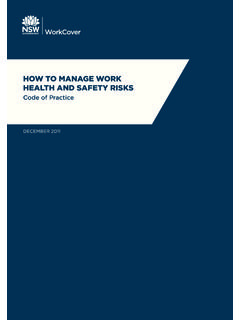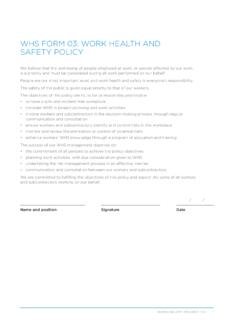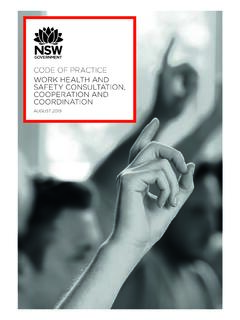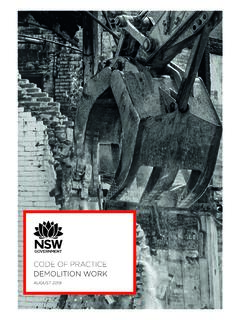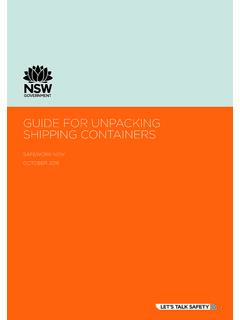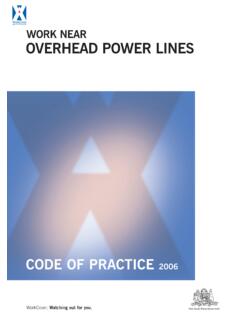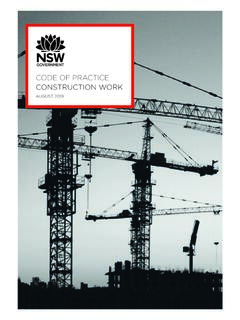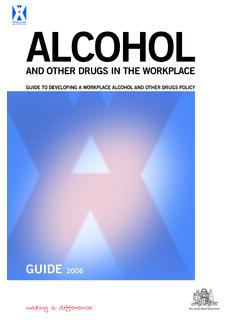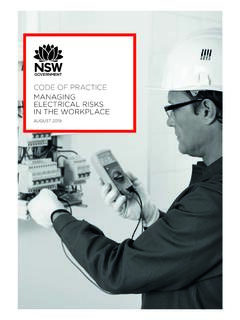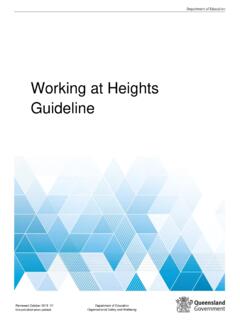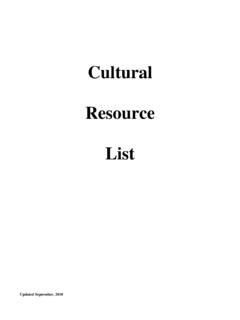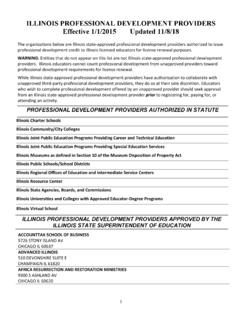Transcription of Safety in the road freight transport industry - SafeWork NSW
1 Safety in the road freight transport industry AUSTRALIAN LONG DISTANCEOWNER & DRIVERSASSOCIATION NSW gratefully acknowledges Workplace Health and Safety Queensland and WorkSafe Victoria for the information gleaned from their publications on developing a traffic management plan, safe handling when securing loads on trucks, unloading flatbed truck trailers, getting in and out of truck cabins, and preventing falls. Workplace Health and Safety Queensland and S. Davis are also acknowledged for permission to use their photograph of a worker using a dog and cheater publication may contain work health and Safety and workers compensation information.
2 It may include some of your obligations under the various legislations that WorkCover NSW administers. To ensure you comply with your legal obligations you must refer to the appropriate on the latest laws can be checked by visiting the NSW legislation website publication does not represent a comprehensive statement of the law as it applies to particular problems or to individuals or as a substitute for legal advice. You should seek independent legal advice if you need assistance on the application of the law to your situation. WorkCover NSWC ontentsIntroduction 2 Manual tasks when handling freight 3 Falls from heights 5 Securing loads 8 Traffic management loading/unloading freight 12 Wellness 14 After a workplace injury what happens next?
3 16 More information 18 Checklist: How safe are you working ? 19 Safe pick-up and delivery form 212 WORKCOVER NSWI ntroductionThis guide provides health and Safety information for road freight transport s Focus on industry Program has identified road freight transport as one of the state s high-risk industries, with a high number of injuries and with the industry and wider community, this program aims to reduce workers exposure to workplace hazards, raise awareness of wellness issues, and improve return to work outcomes for injured key issues the industry faces include: manual handling of freight falls securing loads onsite traffic management wellness returning to work after an the online checklist to measure how well you manage these issues, and implement the solutions outlined in this guide to eliminate or minimise any risks you average, 10 truck drivers are killed on NSW roads every a transport operator, cooperation of others in the supply chain is essential for the Safety of your workers during pick-up and delivery of freight .
4 Use this guide to show other businesses they have a responsibility to work with you to ensure everyone is IN THE road freight transport industry 3 Manual tasks when handling freightWhat is the problem?Workers injured while manually handling are the risks?Heavy lifting, awkward postures, long periods doing the same movements, and inappropriate plant and equipment are the most common cause of injuries when manually handling per cent of injuries are caused by manual is a solution to the problem?ResponsibilitiesA number of businesses may be involved in loading/unloading freight , such as: the transport operator the business where freight is loaded/unloaded the business that controls mobile plant at the workplace where freight is loaded/unloaded the consignor or consignee of the the workplace health and Safety laws, each business shares responsibility for the health and Safety of those involved in the work, to the extent of their capacity to influence and control the work.
5 Everyone must work together to ensure manual handling risks are eliminated, or if this not possible, minimised. A safe work procedure may assist with operatorThe transport operator should: Eliminate or reduce the need to manually handle freight particularly heavy, awkward or bulky items by making available suitable, well-maintained equipment, such as forklifts, trolleys, pallet jacks or tailgate lifters. Work with the business where the freight is loaded/unloaded to ensure the size, weight and shape of the items are configured for safe handling. In some cases, it may be necessary to:reduce the size and weight of the itemswhere applicable, check the integrity of the pack or unituse pallets for bulk deliveries, unstable items (eg grain), and small consignments of dangerous goods.
6 Work with the business where freight is loaded/unloaded to ensure the distance from the pick-up/drop-off point to the vehicle is as short as possible. Configure the load to ensure items are easily accessible when unloading. Ensure work is undertaken at a safe pace and avoid high workloads where possible. Talk to those involved in loading/unloading about the physical demands of the job, the time required to perform it safely and effectively, plant and equipment requirements, and any protective clothing requirements. Provide workers with stable non-slip footwear, high-visibility vests and, if required, suitable protective clothing such as overalls and gloves.
7 Provide instruction and training on handling freight and using equipment safely. Select equipment that the user can push rather than pull it involves less pressure on the lower back and fewer awkward postures, maximises use of body weight and allows better vision for the average, transport -related manual handling injuries cost $17, where freight is loaded/unloadedThe business where freight is loaded/unloaded should talk to: the manufacturer/supplier of the freight , to ensure the shape and design of freight allows for safe loading/unloading the transport operator (before dispatch), to ensure they are aware of the weight and shape of the load, and any particular risks associated with handling the freight and the equipment needed to load and WORKCOVER NSWThe business should also consider.
8 Workplace layoutEnsure that pedestrians are separated from the loading/unloading enough space to operate mobile plant, such as forklifts and loading docks to accept vehicles of varying dimensions, and provide easy access and the loading dock has fall prevention devices (eg guard rails).Ensure vehicles can be loaded and unloaded as close as possible to where the freight is that goods can be moved along clear, wide the loading/unloading area is free of clutter, and designed so that workers are not placed in awkward positions eg reaching above shoulder height , bending in 10 injured workers with manual handling injuries are off work for a week or more.
9 Physical environmentInstall non-slip surfaces, signs and road markings for mobile plant and loading/unloading area is well stairs, ramps or walkways for pedestrians and drivers, away from the loading/unloading area. Skills and knowledgeEnsure forklift operators are appropriately licensed and IN THE road freight transport industry 5 Falls from heightsWhat is the problem?Drivers are frequently required to work from heights. The design of the vehicle, the type of load transported, the collection and delivery points can all lead to the driver having to access the cabin, tray or trailer are the risks?The risk of falling from a height increases when: entering and exiting the cabin loading or unloading goods or livestock arranging and restraining loads checking a load at a loading bay or en route to the destination checking livestock tarping or un-tarping undertaking maintenance working at night, in wet or windy conditions, or on uneven in 10 injuries are caused by falling from the cabin or the back of the is a solution to the problem?
10 ResponsibilitiesA number of businesses may be involved in loading and unloading freight , such as: the transport operator the business operating the workplace where freight is being loaded/unloaded the business(es) controlling mobile plant at the the workplace health and Safety laws, each business shares responsibility for the health and Safety of those involved in the work, to the extent of their capacity to influence and control the work. Everyone must work together to ensure the risks associated with falls from a height are eliminated, or if this not possible, accessReduce the risk of injury when accessing or exiting the cabin by.
